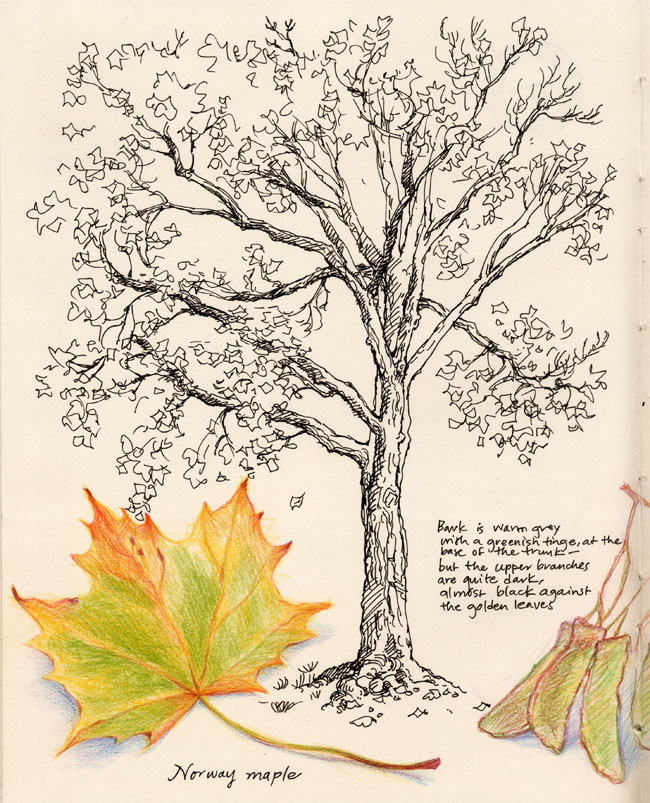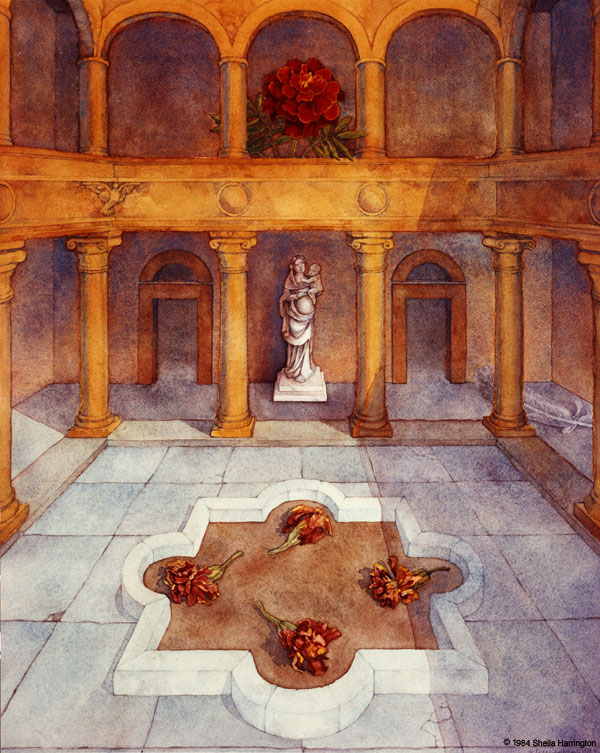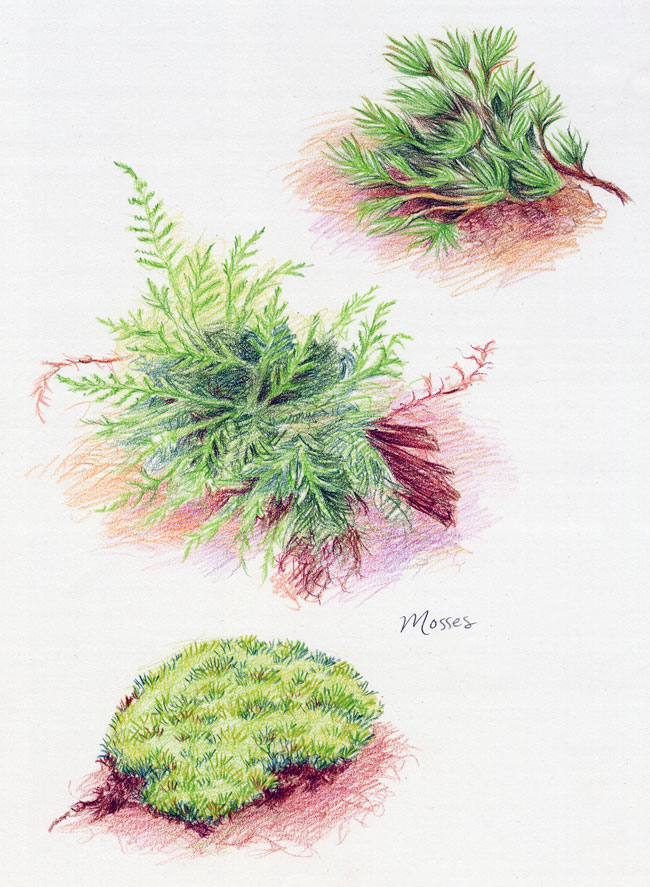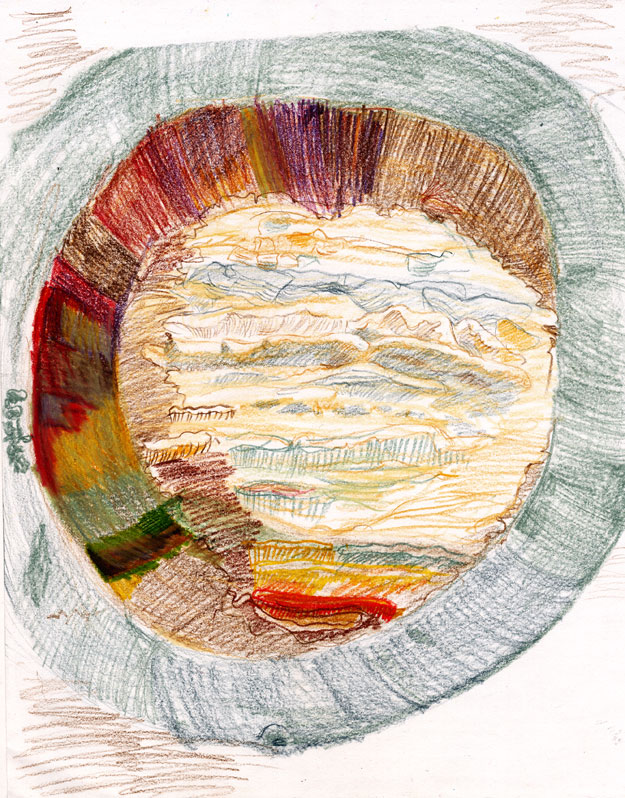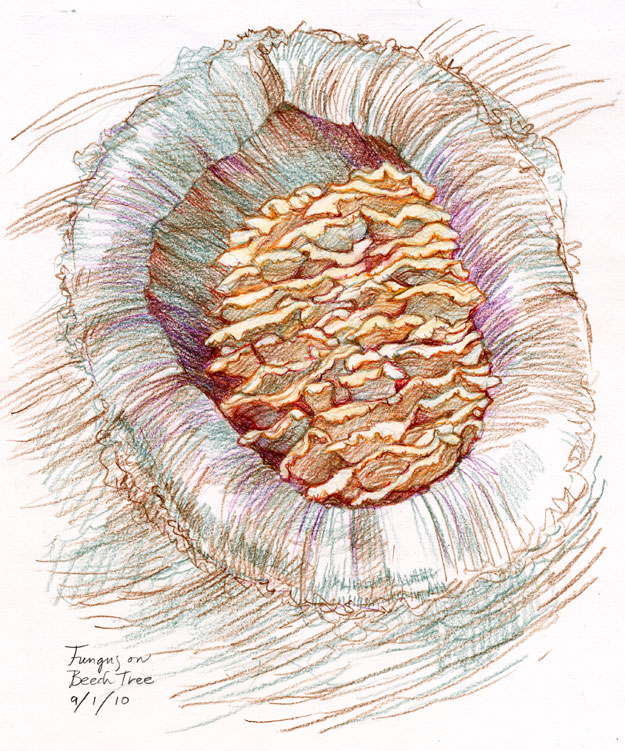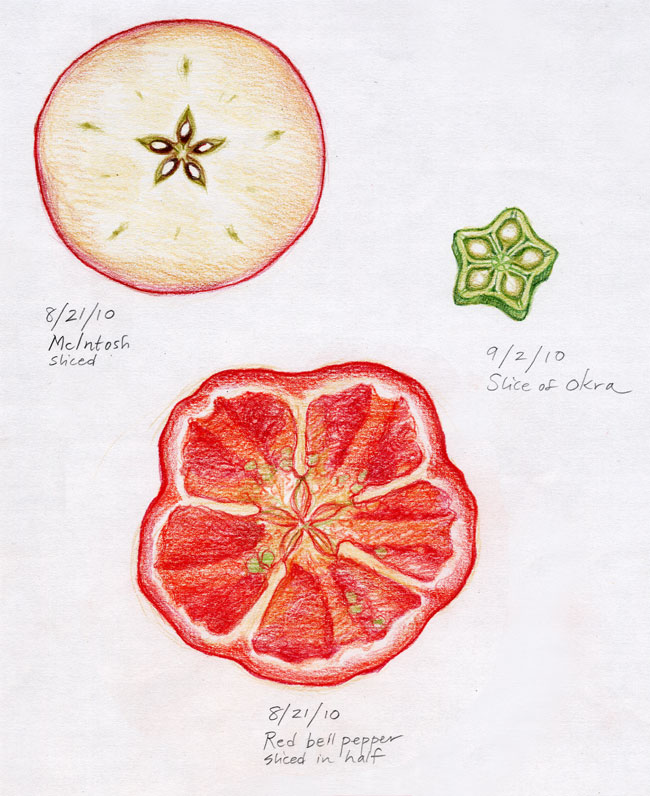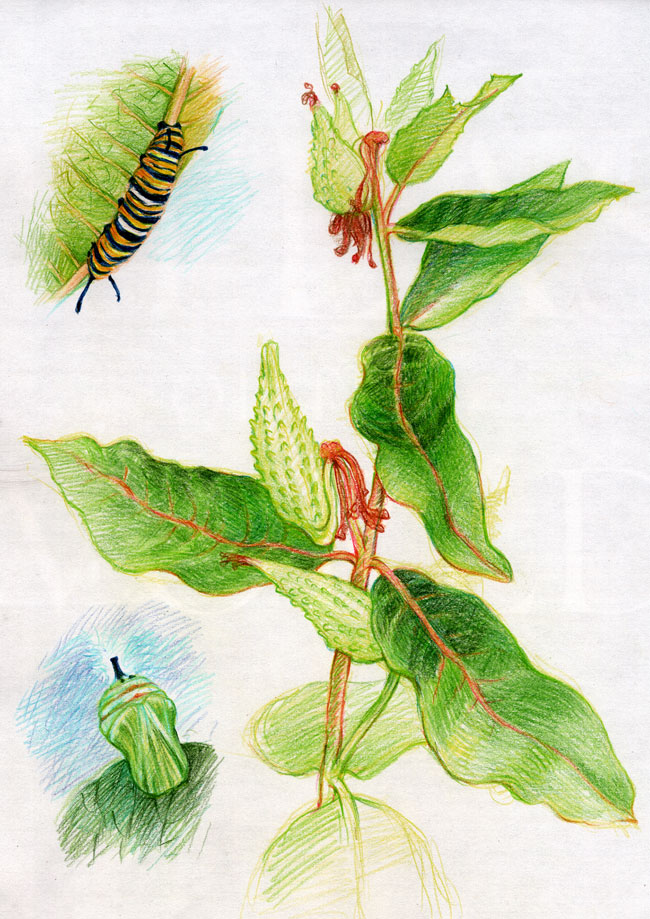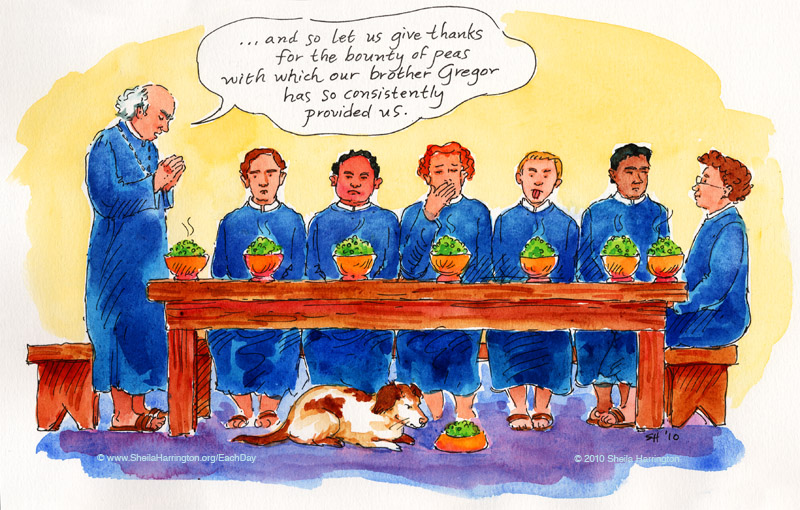My daughter and I have been doing some local tree sketches, then trying to identify them using tree guidebooks upon our return home.
Tag: Botany
this is the garden
In honor of Edward Estlin Cummings (1894-1962), whose birthday it is today, a painting and a poem.
this is the garden: colours come and go, frail azures fluttering from night’s outer wing strong silent greens serenely lingering, absolute lights like baths of golden snow. This is the garden: pursed lips do blow upon cool flutes within wide glooms, and sing (of harps celestial to the quivering string) invisible faces hauntingly and slow. This is the garden. Time shall surely reap and on Death’s blade lie many a flower curled, in other lands where other songs be sung; yet stand They here enraptured, as among the slow deep trees perpetual of sleep some silver-fingered fountain steals the world.—ee cummings![]()
Gathering moss
Fungus, another view
This is my daughter’s drawing of the aforementioned beech tree fungus. She’s done a better job than I did of bringing out its liveliness and color. It now merits a classier name than “fungus.”
Fungus, beech tree
My daughter and I have walked past this beech tree fungus all summer, and we finally stopped one day with our pencils and paper and drew it. The depression in which the fungus growing (which I assume marks a fallen branch) is about ten inches high, and the fungus is surprisingly colorful. My drawing doesn’t really do it justice. My daughter’s is better—I will put that up next week.
Lichen
One of the goals of our Botany block is to explore the range of plant categories we find in our immediate surroundings, wherever we happen to be, from fungus and seaweed to flowering plants and trees. This was our first study of lichen, discovered growing on a fallen twig, and it was quite small. But the more closely we looked, the more we saw.
Lichen is actually two plants, a fungus and an alga, working symbiotically: the fungus provides housing for the alga, and the alga provides food for the fungus. Like many traditional marriages.
Hidden Stars
Some of these summer days have been too hot and mosquito-laden for sketching outside, even early in the morning. So, for our Botany block, my daughter and I have been indoors slicing through some of the fruits of the season, to find the surprises within. Circles! Triangles! Stars! (I’m hoping this will lead very naturally into 6th grade Geometry…)
From Milkweed to Monarch
While house-sitting for friends in Massachusetts, we took care of Flute, their parakeet, and two caterpillars in the dining room. The caterpillars lived on fresh milkweed leaves from the garden. And they sure put away a lot of leaves, chewing audibly beside us during mealtime (and apparently all the rest of the time).
One day they stopped eating and attached themselves to the side of the terrarium, quiet yet pulsating, and seeming to shrink inwardly, their festive green and yellow bodies growing dark and shriveled. I stayed up as late as I could and finally had to crash. In the morning those discarded husks lay on the floor, each replaced by a gleaming jewel-like chrysalis.
Flute was a much jollier and more sociable companion, riding about on our shoulders and chatting throughout the day, but the caterpillars were a (mostly) silent reminder of the daily small miracles that surround us.
Peas of Mind Part II
(Continued from Peas of Mind Part I, July 20)
Speculation on this subject probably dates from prehistory, when nomadic peoples discovered that fallen seed produced new grain, and that it was handier to domesticate sheep than to chase after them in the wild. Selective breeding of plants and animals is thousands of years old.
But how did it all work? Why did sheep vary in color, size, and wool quality? For that matter, why did sheep give birth to lambs instead of, say, lentils? Was it all an unchanging predetermined system, set in motion by a Creator? Was variation due to inner mechanisms, or to external factors, like environmental requirements, or supernatural forces? Did new species generate spontaneously, from water, mud, cheese, and old rags? Was there an underlying material explanation for the workings of the Great Chain of Being?
Every people has had its explanation for the workings of existence. From mythology to religion to philosophy, theories abound. And as the world has shrunk and human consciousness evolves, explanations are increasingly shared, expanded, and abandoned.
By the 17th and 18th centuries, the Western world was seized with a new fever of questioning in all areas of natural science. By the 19th, scientists working independently in diverse fields were moving inexorably from childlike faith in mythology and magic toward a secular, observation-based, material Explanation For Everything. It was the early adolescence of Western thought: Ha! You don’t know everything, God, so I’m going to search for the truth myself! And maybe I’ll find out you’re not even there! Questioners sought to discover universal underlying principles of existence, revealing that they retained a desire for Oneness through science that would replace loss of faith. But that’s another post…
So back to Mendel and his peas. (I realize this is my SECOND post about a monk this month! but that is pure coincidence.)
Pea plants are self-pollinating, but Mendel controlled pollination by removing stamens from selected plants and pollinating specific generations by hand, controlling for one characteristic at a time and keeping detailed mathematical records of the results. His experiments revealed consistently that, although the offspring of a first generation of peas always resembled the parents, the offspring of two crossed generations resembled only ONE parent—and, most surprising, that among the offspring of the hybrids, three out of four peas displayed one parental trait and the fourth pea displayed the other.
Other scientists had previously studied cross-pollination, but without coming to final conclusions or developing laws of inheritance. But Mendel, after growing thirty thousand plants over eight years, deduced the existence of what he called dominant and recessive traits, controlled by elements within the egg cell and the pollen of plants (later called genes). He also concluded that each parent carries half the elements passed on to offspring, and that these individual elements remain present and distinct, controlling specific characteristics like eye and hair color. (We’re no longer talking about peas here, except for unusual, Pixar-type peas.) This was in contrast to others, including Charles Darwin, who thought that characteristics from parents blended within the offspring.
In 1865 Mendel presented his findings to the Natural Sciences Society of Brünn, and later mailed printed copies throughout the scientific community (Darwin got one), but he received little response. Some fellow scientists were confused by his mathematical approach and his talk of distinct inherited traits. And what did peas have to do with people? Mendel was disappointed, but shortly thereafter he was elected abbot of the monastery, and although he continued gardening and beekeeping, his duties left no time for further experimentation. His position, however, now made possible financial assistance for his sister’s children (and a fire house for his home village).
Upon Mendel’s death, his successor burned his papers. (Horrors! I bet there’s a secret story in that.) Fortunately, the papers Mendel had mailed abroad survived. But it wasn’t until the early 1900s that his work was rediscovered by several scientists working independently of one another in Holland, Germany, England, and the United States, taking them by surprise. His work was challenged and his theories modified, but he had grasped certain basic principles of heredity fifty years ahead of anyone else, and terminology was developed for the field of study Mendel had initiated and the mechanisms and processes he had described.
Even though middle school was a LONG time ago, I cannot see peas in a garden without thinking of dear Gregor. Sigh. Including these delicious sugar-snaps growing in our friend Susan’s Vermont garden, which my daughter and I sketched for our Botany block. We picked and ate plenty of them, too. That was for our Gastronomy block.
Peas of Mind Part I
When I was in 8th grade, I had a crush on Gregor Mendel. No, he was not a Czechoslovakian exchange student. He was a 19th-century scientist whose birthday it is today. And what red-blooded schoolgirl would not fall for a man who was fascinated with plant and animal heredity and grew thousands of peas to test a hypothesis, thereby becoming the father of modern genetics? (Well, probably there are a few. But it’s a pattern: in third grade my admiring glances fell upon the boy who won all the class math competitions; and my hubby, a man of diverse talents like sculpture, electrical wiring, and the infant football-carry, is also no slouch in the brains department.)
Gregor Johann Mendel (1822-1884) was born into a farming family in the tiny village of Heinzendorf in what was then the Austrian empire and is now the Czech Republic. A bright boy, curious about the many growing things he observed in his rural world, he quickly outgrew the village grammar school. His parents, though not well-off, paid what they could for him to attend school in the next town—which was tuition plus only half his meals, so Gregor often went hungry.
Funding ended abruptly when Mendel was 16 and a back injury prevented his father from farming. Although he always helped with the farm work, Mendel, the only son, was more interested in studying plants and sheep than in raising them. So eventually the farm was sold to provide for living expenses and daughters’ dowries. Mendel took on tutoring work to continue paying for classes and books. And Mendel’s younger sister used her dowry to help her big brother finish high school. Now THAT is a loving sister.
But university education couldn’t be paid for with tutoring. One teacher suggested a solution: if Mendel didn’t mind giving up the possibility of marriage and family, he could enter an abbey. Friars followed a range of paths. They didn’t spend all their time praying and preaching—they were farmers, beekeepers, bakers, teachers, mathematicians, philosophers, scientists. For centuries this had been the road to education for many bright but poor boys (undoubtedly many of them without a genuine vocation).
So Mendel entered the Augustinian Abbey of St. Thomas in Brno, known for its intellectual pursuits and its enormous library, to continue his education. The abbot, recognizing Mendel’s gifts, sent him on to the University of Vienna to study with leading scientists (one of them Christian Doppler, of Doppler effect fame). When he returned, he taught science at the monastery-run high school, for which he apparently had a natural gift, teaching with refreshing clarity and humor. At the same time he continued his own studies in astronomy, meteorology, zoology, and botany.
Interested in the mysteries of heredity since his farming childhood, he wished to investigate its laws. He began breeding mice of different colors to study the pattern of color inheritance, but the bishop thought the study of mouse-breeding was messy and unsuitable for a monk. So Mendel switched to garden peas, which are better-smelling and less shocking in their reproductive habits (although the subject of plant reproduction had certainly shocked the colleagues of Carolus Linnaeus in the previous century).
Mendel received a garden plot in the monastery’s botanical garden and began to experiment with thirty-four varieties of peas: tall, short, yellow, green, wrinkled, smooth, white blossoms, purple blossoms, grey seed, white seed. His goal was to determine what principles governed heredity. Clearly offspring shared some traits with their parents—but which ones, and why? How were characteristics passed from one generation to the next?
TO BE CONTINUED! See July 21st.

